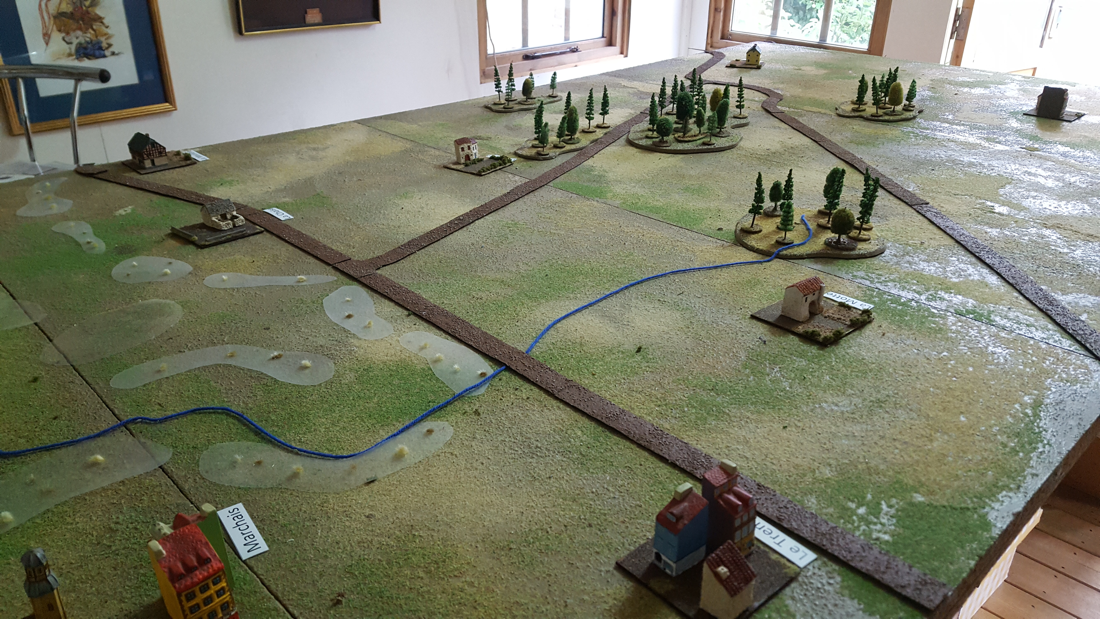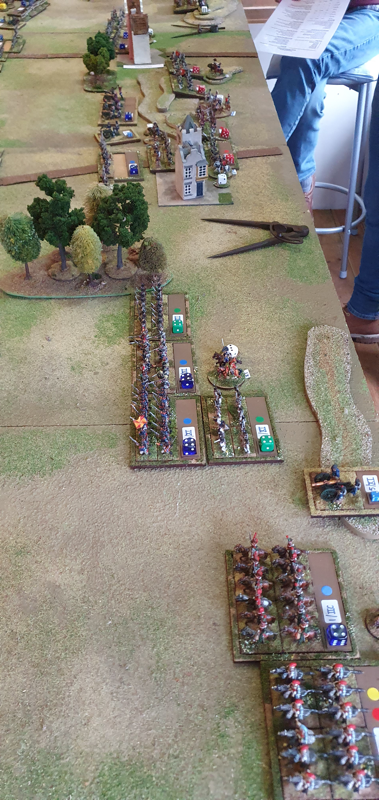|
On 16 August we played a 6 player game using Sam Mustafa’s Blucher rules and 6mm figures, mostly produced by Commission Figurines. The battle was Montmirail, 11 February 1814, using the small scale variant in the rules. Montmirail is an encounter battle in which the French are heavily outnumbered at the start, while the Russians are present in their entirety from turn 1. It is a chance to use the French Guard, who actually constitute the majority of units, and to pit smaller numbers of high quality troops against a numerically superior opponent. But the Russians are no pushover: all their infantry count as steadfast and so are tough on the defensive. Scenario and Setup The scenario, now in its third version, can be found here. The original was a two player scenario at ‘normal’ scale, so one base per brigade. I expanded this to ‘small’ scale, roughly doubling the number of units, but then after a dry run I added a few more, based on a new guesstimate between the different sources. I stuck with the original decision to leave the Young Guard out because only Allied accounts said they were present and Allied witnesses were not great at recognising enemy units (cf mistaking naval artillery for marines of the guard at Leipzig). French accounts were clear that while the Young Guard’s then commander, Ney, was present, he had left his troops behind. If they did reach the field at all, I believe they will have done so after the battle was over. The battlefield was mostly easy to depict. As accounts of the battle say the roads were bad due to heavy rain, I only showed the two main roads: the East-West Little Paris road and the road going north to Chateau-Thierry. I also struggled over how to depict the waterlogged low ground on the Russian right/French left. After first trying to work out a way of modelling the contours here, I concluded I didn’t need to: the issue that affected the battle was the state of the ground, not line of sight. In the end I cut out several irregular pieces from a clear plastic wallet and placed these on the table to represent the area of low marshy ground. It looked quite effective and had the desired effect on play, making the fight in this area an infantry-only affair. How it Played Matt took the role of General Sacken, while Chris was Von Lieven, commanding XI Corps. Keith played Napoleon, Spencer was Ney and Nick was Nansouty. I umpired at the start and came on in the last quarter as General Yorck. At game’s start, the whole Russian army was on the field, facing (count them) four French units. Matt and Chris used the first turn to advance as far forward as possible and close down French options. Chris on the right assaulted the village of Marchais, a struggle that would last all game. Matt advanced his left almost as far as the French baseline, thereby threatening Nick’s flank. Nick slipped a brigade of conscripts into Marchais and tried to look brave with his cavalry. One of these units was almost crippled by Chris’s artillery, which had a couple of high rolling turns. Luckily for the French, Keith and Spencer then arrived with the Old Guard and some more cavalry. Spencer’s Old Guard expanded his room for manoeuvre by assaulting Matt’s cavalry on the Russian left. He pushed Matt back but with heavy losses. Infantry pay a high price for attacking cavalry, although if it is worth the gamble with anybody, the Old Guard is probably the best formation to try. Matt’s cavalry still being potent, Spencer now formed square with two Guard units and sent the other two against the left wing Russian infantry. At this point Napoleon himself joined one of these units and disappeared into the smoke, presumably ignoring the pleas of his aides to move himself out of danger. So what happened next? The French Left and Russian Right fought stoutly over Marchais, which changed hands twice before ending the day in disputed possession (one town base occupied by French and the other by Russians). This denied either side victory points for the town. At the other flank, the French assault chewed up several Russian units but used themselves up in the process. Yorck arrived late but in time to eliminate an exhausted Old Guard unit and to fill gaps in the Allied line. In the Centre, Chris launched an attack on La Motte which was only thinly held by the French, but just too late in the day. Darkness fell with the Russians nearing their break point but still hanging on. With possession of Marchais still in dispute, and to my private disappointment as I dislike a hung result, the day ended in a draw. What might have been
Hindsight is a wonderful thing. The Russian Left did well to take territory and let the French try to dislodge them. On their Right, Chris handled the assault on Marchais well but Nick made good use of his conscripts and the arrival of the Middle Guard allowed him to deny Chris undisputed occupation of the town on almost the last turn. I think, had Chris attacked La Motte sooner, Nick would have been stretched too thin and the outcome at Marchais could have been different. Between the two commanders in chief, Matt stayed in control of his battle while Keith got too involved in the assault by two Old Guard units and lost his overall grasp. Although a drawn battle according to the rules, I consider Matt was the better CinC on the day. By general agreement, Nick made good use of his meagre numbers. Twice in the last turn of the game, the Russians were within an unlucky dice roll of reaching break point. Fortunately for them, they didn’t. This was also fortunate for me, as after the game ended I realised I had made an umpiring mistake. Around a quarter of the way through the game, I had allowed Nick to send a cavalry unit into the rear of a Russian artillery unit, wiping it out. When I checked the photographs and reread the rules the next day, I found that this charge had been illegal, since the artillery’s rear had been protected by the 1BW zone of control of a neighbouring infantry unit. If it charged anybody, the cavalry should have charged this unit. So I apologise to Matt and Chris for my error: you were two units away from breaking at nightfall, not one. I hope the team enjoyed the game. There’s more to be explored in this scenario and I have kept the stickers on the units, in case we can have another go at it some time. It’s curious that wargamers don’t often replay the same battle with miniatures, whereas it is common to play the same board game several times over.
0 Comments
Leave a Reply. |
Archives
November 2023
Categories
All
|









 RSS Feed
RSS Feed